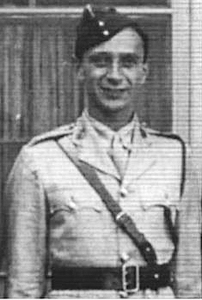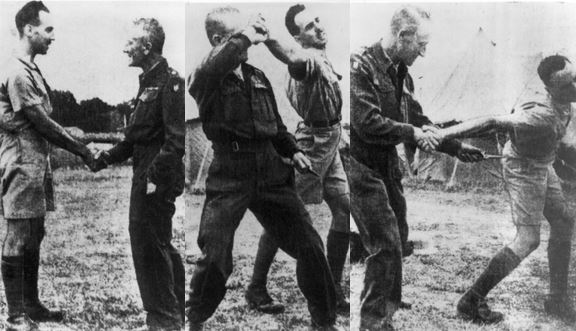|
Did you know?
Copyright © Lynn Philip Hodgson
THAT: Paul Edward Dehn, (b. 1912, d. 1976), noted film critic, lyricist and Oscar winning co-writer, screen story, with James Bernard of Seven Days to Noon, 1950 (awarded 1952) was in fact Major Dehn, SOE, the Political Warfare instructor at Camp-X, 1942 – 1944.

Paul Edward Dehn
The Oxford educated Dehn’s prolific post war production included more than a dozen principal or co-screenwriting credits garnering him Writers’ Guild nominations and/or Edgar Allan Poe awards for The Spy Who Came In From The Cold, 1965, The Night of the Generals, 1967 and Murder on the Orient Express, 1974. Paul Dehn co-produced and co-scripted a thriller, Fragment of Fear, 1970. Between 1970-1973, he wrote two screenplays and is credited for two motion picture stories in The Planet of The Apes ‘franchise’.
In 1964, Paul Dehn collaborated with Ian Fleming on the screenplay for Fleming’s Goldfinger. Why should this be of more than passing interest? Major Dehn and Commander Fleming met and became friends at Camp-X, during the short period while British Naval Intelligence officer Ian Fleming was visiting the Canadian SOE/BSC special training school.
Of the twenty-one and counting, pure or ‘knock-off’ Bondian films at time of writing, Goldfinger is generally regarded by legions of fans as one of the five all time best, and arguably superior to the book. Sean Connery’s, Honor Blackman’s and Gert Frobe’s portrayals are memorable. However it is the writing: relatively tightly plotted, with sharply written, witty dialogue, full of self deprecating humour and classic deadpan double entendres, that stands as a tribute to the producers’ astuteness in pairing these two men as co-writers whose backgrounds in intelligence and their shared remembrances of unconventional warfare training, albeit experienced briefly at Camp-X, yielded box office gold.
A fascinating tale is the following:
Paul Dehn was a brilliant Brit who was sent to Camp-X in 1942 to operate as the ‘Political Warfare Instructor’ and a marvelous screenplay writer before the war.
When Ian Fleming visiting Camp-X during the summer of 1942, the camp was at capacity and there was no room for visitors. The camp commandant encouraged visitors, J. Edgar Hoover, Wild Bill Donovan, and others to stay at local hotels such as the Blue Swallow and the Genosha in Oshawa. In Fleming’s case, he had friends who lived on Avenue Road in Toronto and elected to stay with them.
Each morning Fleming would sit on the porch with a cup of tea while waiting for a staff car from the camp to pick him up. What did he stare at every morning while waiting for his lift, St. James Bond United Church, directly across the street!
Often Fleming and other instructors would go into Oshawa to the Genosha Hotel for some entertainment. Parking was at the back of the hotel and could only be entered by, you guessed it, ‘Bond Street’!
And now you know, the rest of the story!

THAT: Sterling (Stirling) Hayden (b.1916, Jersey City, New Jersey, as Sterling Relyea Walter? John Hamilton? Credited after 1947 as Stirling Hayden, d. 1986, Sausalito, California). Stirling Hayden is remembered for his early screen portrayals as a handsome, complex, archetypically hard bitten noir B-movie ‘wrong–side-of–the–law’ loner (e.g. The Asphalt Jungle 1950, The Killing 1956). By the mid ‘60’s, Stirling Hayden had become a first rate A-list actor, creating memorably ‘off kilter’ characterizations with Directors Kubrick in Dr. Strangelove 1964, Coppola in The Godfather Part 1 1972, and Altman in The Long Goodbye 1973.

Sterling (Stirling) Hayden
Hayden, the seaman/ship’s captain/adventurer, maritime historian, acclaimed author (Wanderer, autobiography 1963, Voyage, novel 1976) and reluctant film star abruptly quit his Hollywood career to join the USMC. In 1941, Lieutenant Hayden transferred to Office of Strategic Services (OSS), quickly winning promotion, and assuming the nom de guerre Captain Hamilton. Captain Hayden was subsequently awarded the Silver Star for his work in running guns and materiel through the Axis blockade of the Adriatic to supply Marshal Tito’s Yugoslav Partisans. Hayden personally witnessed the destruction of Belgrade in 1941, chagrined that he was unable to provide additional arms and ammunition from his supply base at Papuk, to reinforce the city’s defences. He and Tito had become close friends, such that Hayden attended the Marshal’s funeral in 1980, in the Serbian capitol, Belgrade, ostensibly for Rolling Stone magazine, and “…to say goodbye to an old friend.”
Stirling Hayden’s brief post war flirtation with and rejection of communism, his testimony as a ‘friendly witness’ to HUAC, the House Un-American Activities Committee, his personal travails and eventual return to film celebrity are well documented in his autobiographical masterpiece, Wanderer and are beyond the scope and intent of this article.
Less well known known, and inexplicably not documented in his Silver Star citation is Captain Hayden/Hamilton’s highly successful operation of underground escape networks for ‘downed’ American and Allied fliers in Yugoslavia. Frequently personally vetting and escorting airmen at great personal risk to partisan ‘safe houses’ Hayden was responsible for the return of scores of fliers to safe haven in Bari and Brindisi, Italy.

THAT: Lieutenant Colonel William Ewart Fairbairn was fifty-nine years of age when he was called upon to serve his country by going to Canada as the Chief Instructor at Canada’s top secret spy school, Camp-X.

Lieutenant Colonel William Ewart Fairbairn
William Ewart Fairbairn, General List, was born February 28, 1885 in Rickmansworth, Herts, England. Prior to the Second World War, Fairbairn was the Chief Instructor at the Shanghai Municipal Police from October 1907 to March 1940. Fairbairn joined SOE in March 1942 with the rank of Captain, having previously been an instructor at the War Office Special Training Centre in Scotland in July of 1940.

Fairbairn demonstrates the art of ‘Silent Killing’
Major Fairbairn illustrates the art of ‘silent killing’. Within moments of shaking hands with Fairbairn, an unsuspecting man can only muster up a silent gasp before death.
Immediately after joining SOE, he was posted to STS 103 (Camp-X) as Chief Instructor and granted local rank of Major on June 8, 1942. Lieutenant Colonel Fairbairn was fifty-nine years old when he accepted this assignment to physically train men thirty years his junior! Lieutenant Colonel Fairbairn was unquestionably the most experienced and accomplished person at that time in the art of ‘silent killing’. The fact that Fairbairn was sent immediately to Camp-X attests to the importance that the British Secret Service put on Camp-X.
While in Scotland, prior to coming to Camp-X, Fairbairn personally trained the ‘Anthropoids’ team which successfully assassinated Reinhard Heydrich, The Butcher of Prague, on May 27, 1942.

THAT: Author Ian Lancaster Fleming’s inspiration for the name of his fictional MI-6 secret agent, James Bond, might have had its origins in Toronto, Canada.

Ian Lancaster Fleming
When British Naval Intelligence Commander Ian Fleming was invited by Sir William Stephenson, Intrepid, to observe and participate in the SOE subversive warfare training Syllabus at STS 103 (Camp-X), he was billeted at a private home on Avenue Road, Toronto, as at the time the Camp was at capacity.
A pre-war journalist of some repute with Reuters, Fleming, then personal assistant to the Director of Naval Intelligence (DNI), had of necessity become a serious student of the minutiae of daily life. As a VIP guest of Sir William’s, a staff driver chauffeured Commander Fleming to and from the Camp. Clearly visible across Avenue Road when entering or leaving his temporary residence was a large sign at the front entrance of Saint James Bond United Church.

(Photo credit: JD DeLuzio - London, Ontario, Canada)
When, in 1952, having undertaken to write a spy novel (Casino Royale) as a release from the rigours and responsibilities of entering married life with fatherhood imminent at the age forty-four, it is suggested that he noticed a favourite book on exotic birds lying on the coffee table, by the American ornithologist James Bond.
Which was it then… the book or the church… or both? We’ll never know.
Regarding his hero Bond’s ‘license to kill’ i.e. 007… That’s another story with Toronto implications.

THAT: The first commandant of Camp-X was scheduled to be none other than ‘Kim’ Philby! Yes, the British/Soviet ‘mole’, Harold Adrian Russell Kim Philby, of MI-6/KGB notoriety.

‘Kim’ Philby
Kim Philby had briefly served as an instructor at Beaulieu, the top notch SOE ‘finishing school’ in England. He was stationed there along with fellow KGB conspirators Guy Burgess and Donald McLean. While at Beaulieu, Philby contributed to the writing of SOE Syllabus, or training manual. Whether upon instructions from Moscow, or of his own accord, or both, Philby managed to convince his superiors in MI-6 that he was of far greater value to the British in England than he ever could be in Canada.
Had MI-6/SOE insisted upon Philby’s transfer, how vastly different might the ‘secret wars’ of 1940 to 1963, and beyond, have played out?
Now you know!
|

 (289) 828-5529
(289) 828-5529